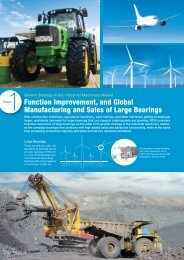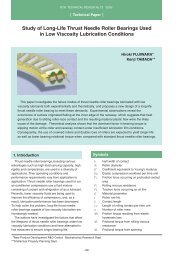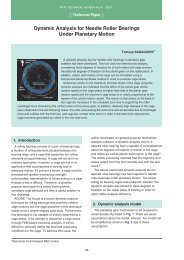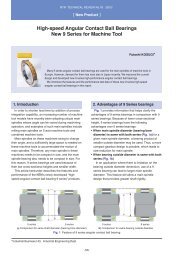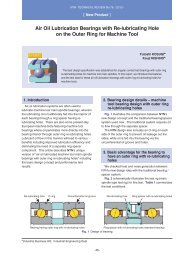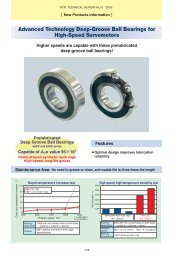Special Issue; Products for Industrial Machinery - NTN
Special Issue; Products for Industrial Machinery - NTN
Special Issue; Products for Industrial Machinery - NTN
Create successful ePaper yourself
Turn your PDF publications into a flip-book with our unique Google optimized e-Paper software.
<strong>NTN</strong> TECHNICAL REVIEW No.742006<br />
Direction of load transfer<br />
Direction of load transfer<br />
aDriving roller side, current<br />
density of 1.0 mA/cm 2<br />
bDriving roller side, current<br />
density of 0.3 mA/cm 2<br />
Fig. 12 Photographs of surface cracks and their circumferential cross sections<br />
characteristics of penetration of diffusible hydrogen on<br />
the possibility of premature flaking. This effect was<br />
examined by repeatedly applying circumferential<br />
tensile stress to the rolling surface in a double-roller<br />
test using an ultrasonic fatigue test.<br />
The dynamics of contact between the rollers were<br />
calculated under the loading conditions of the doubleroller<br />
test. The calculation results are illustrated in<br />
Figs. 13(a) and 13(b). Contact pressure distribution is<br />
provided in Fig. 13(a), while Fig. 13(b) shows<br />
circumferential tensile stress distribution on the rolling<br />
surface along the X-X line where the tensile stress<br />
maximizes on the edge of the contact ellipsoid. When<br />
the rolling friction coefficient is 0, the maximum tensile<br />
stress of both contact edges is 214 MPa. When the<br />
rolling friction coefficient is 0.1, the maximum tensile<br />
stress of one contact edge becomes 531 MPa.<br />
From the results of the ultrasonic fatigue test, as<br />
shown in Fig. 14, the 10% fatigue strength after 10 7<br />
load application cycles is 981 MPa when there is no<br />
diffusible hydrogen penetration. This strength is<br />
sufficiently greater than the results shown in Fig.<br />
13(b). In contrast, the 10% fatigue strength dropped to<br />
460 MPa when diffusible hydrogen penetrated the<br />
material, as in the result of the ultrasonic fatigue test<br />
with a hydrogen pre-charging current density of 0.3<br />
mA/cm 2 (4.5 wt-ppm). Consequently, if hydrogen<br />
penetrates the material, cracks can occur at a tensile<br />
stress less than those shown in Fig. 13(b).<br />
As summarized above, if <strong>for</strong> any reason the rolling<br />
friction coefficient becomes greater and a large<br />
amount of diffusible hydrogen penetrates the material<br />
at the same time, there is a higher possibility of crack<br />
occurrence on the rolling surface, which can lead to<br />
premature flaking. However, to verify this assumption,<br />
it will be necessary to prove that diffusible hydrogen<br />
penetrates the material in an amount sufficient enough<br />
to lower the fatigue strength of the material in the<br />
rolling contact mode. Detailed research ef<strong>for</strong>ts <strong>for</strong><br />
quantitative verification of the effects of hydrogen on<br />
rolling fatigue were made from the 1950’s to the<br />
1970’s. Grunberg et al. proposed a theory that the<br />
loss in rolling life of a steel material due to ingress of<br />
water is caused by hydrogen derived from the water. 9)-<br />
11)<br />
This theory was supported by Scharzberg et al. 12),13)<br />
Axial coordinate<br />
1.0<br />
0.5<br />
0.0<br />
-0.5<br />
-1.0<br />
-0.5 0.0 0.5GPa<br />
(a) Contact pressure distribution between two rollers<br />
Stress, MPa<br />
1400<br />
1200<br />
1000<br />
800<br />
600<br />
400<br />
200<br />
X<br />
531MPa<br />
214MPa<br />
0.1<br />
0<br />
0<br />
-0.5 0.0 0.5<br />
Circumferential coordinate mm<br />
(b) Distribution of circumferential tensile stress working on<br />
the contact surface along the X-X line<br />
Fig. 13 Distribution of circumferential tensile stress<br />
at contact surface along X-X line<br />
X<br />
2.5<br />
2.0<br />
1.5<br />
1.0<br />
0.5<br />
0.0<br />
-60-


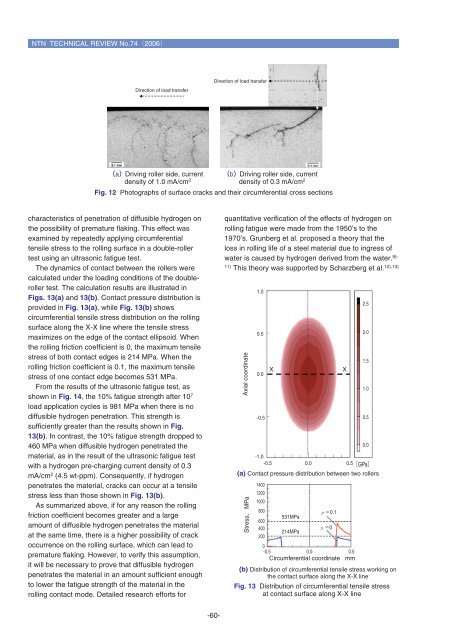
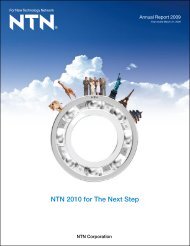
![[New Product] Unit Products for Office Equipment - NTN](https://img.yumpu.com/27154451/1/184x260/new-product-unit-products-for-office-equipment-ntn.jpg?quality=85)
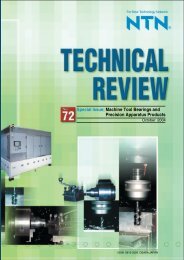
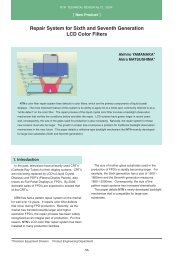
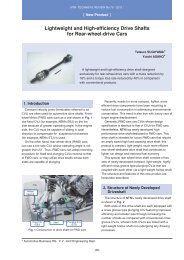
![[New Product] Development of Oil-impregnated Sintered ... - NTN](https://img.yumpu.com/27154427/1/184x260/new-product-development-of-oil-impregnated-sintered-ntn.jpg?quality=85)

